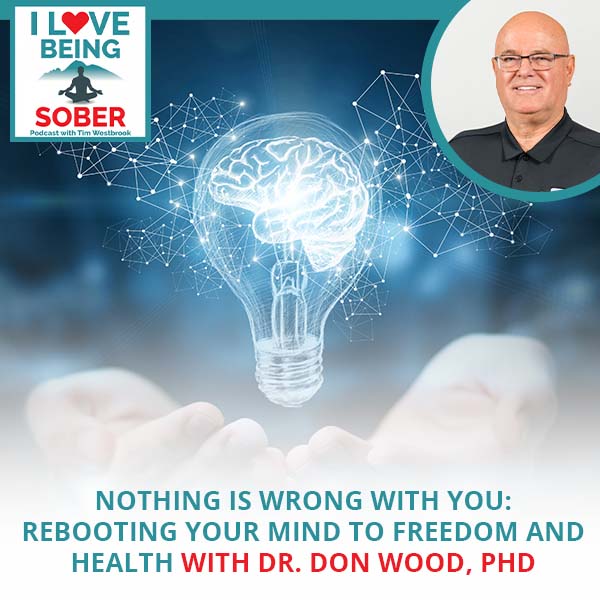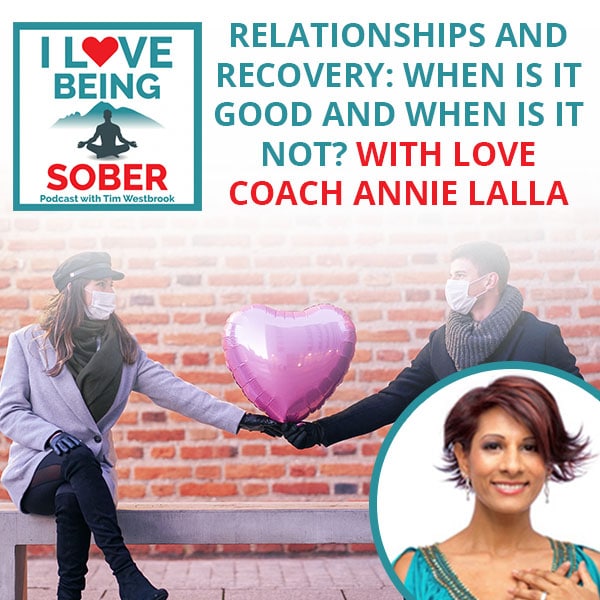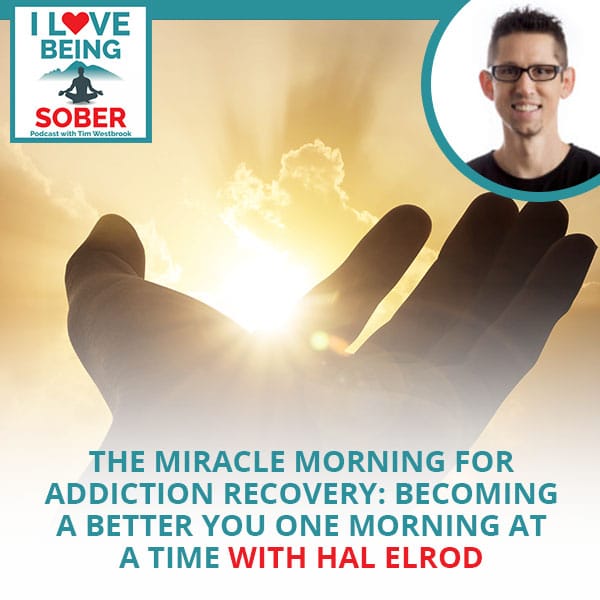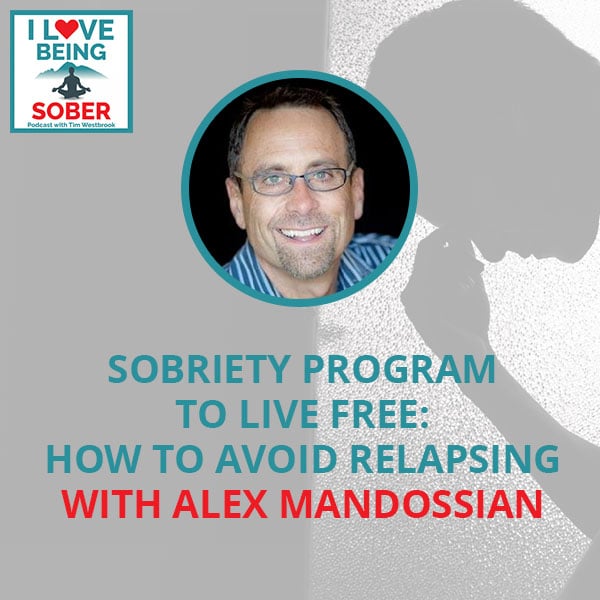
Are you suffering from addiction? There’s nothing wrong with you; your mind just needs a reboot. Tim Westbrook welcomes Dr. Don Wood, Ph.D., the CEO at Inspired Performance Institute. Trauma is at the root of all addiction. So to heal addiction, figure out a way to heal the trauma. When you have lingering painful memories, your brain is still trying to resolve them—putting you in a constant fight or flight response. The reaction is an emergency management system designed to turn on when there’s a threat and turn off when there’s no threat. Join in the conversation and discover how you can start the process of healing.
—
Watch the episode here:
Listen to the podcast here:
Nothing Is Wrong With You: Rebooting Your Mind To Freedom And Health With Dr. Don Wood, PhD
We started the show because there’s so much misinformation about addiction treatment, mental illness and recovery, in general. There’s so much more to recovery than just going to inpatient treatment, seeing a therapist and going to Twelve-Step meetings. All those things are important and AA saved my life. However, to find long-term recovery and live happy, joyous and free, there’s a lot more to it than stopping the drinking, stopping the drugs, stopping the sex addiction or stopping any addictive behavior for that matter.
To live a new life, a person needs new healthy lifestyle habits, amongst other things in order to get there. Typically, this includes new eating habits, exercise habits, sleeping habits, hobbies, interests, friends, self-care becomes a priority and the list goes on. Those are the types of things we talk about here on the show, amongst other things. In this episode, I’m here with Dr. Don Wood, PhD. to discuss The Inspired Performance Program, also known as TIPP.
Dr. Wood has helped trauma survivors from the Boston Marathon bombing attack, the Las Vegas shooting, and many successful executives and world-class athletes. Marko Cheseto, a double amputee marathon runner, broke the world record twice after completing TIPP. Chris Nikic worked with Dr. Wood and made world news by becoming the first person with down syndrome to complete IRONMAN. The Inspired Performance Institute was built on the simple phrase, “There’s nothing wrong with you. There’s nothing wrong with your mind. Rather, during your lifetime, some events and experiences have created some glitches and error messages for your mind, and all you need is a reboot.”
—-
Dr. Wood, welcome to the show. I’m so glad to have you here.
That’s great, Tim. Thank you so much. We’ve been talking for a little while about getting together and doing this, so I’m excited to be here.
I’m grateful that you’re here. It finally worked out, so you’re here. We’ll dig into it. What gives you the right to claim you’re an expert on the healing of trauma?
It started because of my experience with my wife and my daughter. My wife had experienced trauma as a child. I never did. I didn’t have any trauma. Some bumped along the way, but nothing could be considered trauma that she dealt with. She had a very violent home and a very angry father. My daughter ended up with Crohn’s and another autoimmune called idiopathic pulmonary hemosiderosis. What I did is in trying to find more solutions for my daughter, I started researching and made the connection between trauma and inflammation. This unresolved trauma then starts to affect your immune system and neurotransmitters.
People will start getting sicker because their immune system is compromised and the neuro-transmitters will start feeling bad, so they’re going to be looking for ways to try to help relieve that. Everything was all built around teaching people to live, manage and cope with it. I said, “Why aren’t we fixing it?” That’s what I did. I developed a program to heal the trauma so that it didn’t continue to affect our day-to-day lives.
The next question I was going to ask you was what specific incident inspired you to be so passionate about this topic, but you had already answered that question. Trauma is all around us and many people say that trauma is at the root of all addiction. To heal trauma and figure out a way to heal the trauma seems like a really big thing that you’ve been able to figure out how to do. How did that work out? How were you able to figure out how to heal trauma, process trauma or get through the trauma?
I started to study what was being done. As I said, everything was all built around managing it. People would say, “I have anxiety.” “We’re going to teach you how to live with anxiety. We’re going to give you medication.” “I have depression.” “We’re going to give you antidepressants and anti-anxiety medication.” That’s not fixing it. That’s managing it.
What is creating it? When somebody comes into me and says, “I have anxiety,” I say, “No, that’s a symptom. That’s not what you have.” Many times people identify what their symptom is what they have. I say, “The mind is brilliant. It does everything for a reason. It creates anxiety, depression or post-traumatic stress for a reason. It’s not doing it because there’s something wrong with you. It’s doing it for a purpose.”
It’s doing it to protect you.
When people say to me and this is such a great conversation for addiction. They’re like, “I sabotage myself.” What I say to them is, “It’s impossible. You can’t sabotage yourself. The brain is not designed to sabotage itself. It’s designed to survive. It’s creating a purpose to whatever it is asking for.” Whenever you have an emotion, a feeling, a sensation or a thought, your mind is calling for action. What is it calling you to do? A lot of times in trauma, it’s calling for you to do something about the trauma. The problem is the trauma doesn’t exist anymore, but the mind, the survival brain or your subconscious mind, operates in real-time. It’s fully present. It’s looking at data from years ago in real-time.
[bctt tweet=”Unresolved trauma compromises your immune system and neurotransmitters, making you sick.” via=”no”]If your mind saw a threat to you even though it’s a threat from memory and thinks it’s real, doesn’t it make sense that it would call for action? The purpose of fear is to escape a threat. The purpose of anger is to attack a threat. If you think about something that happened to you years ago and your heart’s racing, that means your mind is looking at that data in real-time, calling for you to run. That’s the glitch that I’m talking about. It’s an error message.
I was in a major car accident in 1996. I walked away with a traumatic brain injury. I was in ICU with 24-hour care for 28 days at the Transitional Living Centre for brain-injured adults. It was a big deal. Again, that was in 1996, but even now, I can’t fall asleep in a car. Even if I’m going on a long road trip and I’m exhausted, I cannot fall asleep in a car. Would you call that a glitch?
Yes. The reason you can’t do that is your mind is trying to protect you. When you go to get into the car, your subconscious is surveying its environment constantly. When you get towards a car and you think about falling asleep in the car, what your mind does is like Google Search. It’s like, “What do we know about falling asleep in cars?” It then starts looking at the data from 1996 and thinks there’s going to be a car accident, so it doesn’t want to let you sleep. It’s trying to keep you awake. That’s protection. That’s not sabotage. The idea is as long as that loop is continuing to play, you will continue to experience that. What we have to do is reboot the system.
Is that where The Inspired Performance Program comes in?
Correct.
Tell me exactly how it works.
The key was to understand where the problem is coming from. It’s coming from memory. Trauma is a loop that continues to run in real-time. A simple way to explain it is if I asked you what you ate for dinner, can you tell me what you ate for dinner?
Yes.
What did you have?
I went to CAVA and I had pita wrap with lamb.
Being videoed here, we can see what you did. You looked over to your left. You saw pictures of what you ate and probably where you were. That’s how you stored the information about dinner. Because the dinner wasn’t threatening or disturbing, it’s stored as a fairly low-resolution file, but only humans store explicit details of events and experiences. Animals don’t do that. Everything we’ve ever seen, heard, touched and experienced in our lifetime has been recorded and stored in this memory system.
Ninety-five percent of your mind, which is your subconscious mind, is operating in the present like the animal mind. Animals are 100% fully present. Everything for an animal is happening now. Ninety-five percent of our mind works like that. If 95% of your mind is operating in real-time and it accesses memory from 1996 when it looks at the data, when does it think it’s happening?
Right now.
If it was happening right now, does it make sense that it would create a response to it?

Nothing Wrong With You: Your fight or flight response is an emergency management system designed to turn on when there’s a threat and turn off when there’s no threat.
Yes.
That’s the glitch I’m talking about. What I do and what I’ve developed is a program that we’re going to take that event that you had experienced. All your senses are heightened during a traumatic event like sight, smell and hearing. It’s recording it in high definition with tremendous amounts of detail and data. Now, this high-definition data has been recorded and being reviewed by the subconscious mind. It’s so intense because there’s so much detail to it that then creates a response to it. What we’re going to do is get your mind to reprocess that data into the same format as to what you ate for dinner. It then stops calling for action. We can do that very simply.
What does that look like?
We do a four-hour program. In those four hours, the first two hours are designed to work on the education and science behind what you’re experiencing. I take a lot of the mystery out of it. That’s why I say, “There’s nothing wrong with you. There’s nothing wrong with your mind. If I’ve experienced what you had experienced, I’d be experiencing it exactly the same thing as you did.” That’s how our minds work.
For people who have had a lot of traumas in their life, that trauma is staying active and constantly creating responses in the nervous system. Your nervous system is being activated on an ongoing basis. It’s not meant to do that. It’s meant to respond to a current threat. The problem is this glitch keeps on occurring, so what’s going to happen is that people are then going to get sicker because it’s going to compromise the system.
Your fight or flight response is an emergency management system designed to turn on when there’s a threat and turn off when there’s no threat. It’s perfectly designed. It works exactly like that in the animal world. If a rabbit, for example, gets a sensation of hunger, the rabbit’s mind produces the sensation. Why is it producing the sensation? It’s to get the rabbit to eat. The rabbit starts eating carrots, looks up and sees a wolf. What’s going to happen to the sensation of hunger?
It goes away.
It is instantly replaced by the more appropriate response to the wolf, which is fear. The purpose of fear is to make the rabbit alert and strong. There’s more blood flow to the muscle groups and more adrenaline. The rabbit takes off, gets into his rabbit hole and can’t see the wolf, hear the wolf, or smell the wolf. What’s going to happen to fear? It shuts off. It’s a perfectly designed system. We have the exact same operating system, but we store details about the events with the wolf and that continues to activate that nervous system in real-time.
We can’t forget the wolf. We think the wolf is still there even though the wolf is not there.
Yeah. The mind is seeing that. Hollywood has made trillions of dollars from this. They can convince us in a movie theater that something’s real on the screen because our subconscious mind can’t tell the difference between real and imagined. You could go into a movie and say, “Whatever happens, I’m not going to get scared. I know it’s just a movie.” That’s the conscious part of your mind. The 5% of your mind operates on a conscious, logical and reasonable part. It’s our intellect.
It’s how we’ve created the world we live in with computers, automobiles and airplanes. If we couldn’t do something, we figured out a way to do it. That part of our brain is brilliant, but it’s not in charge of survival. Survival is controlled by the subconscious part of the brain. That’s where it continues to get activated because memory continues to run and loop when there’s something. As you said, when you think about getting into a car and sleeping, your mind says, “What do we know about that?” It then starts looking at the data and instantly creates a response to it. Does that make sense?
Yes. Let’s use one of the people that you specifically treated, the Boston Marathon bombing attack survivor, as an example. Walk me through that situation.
When Rebekah came in to see us, she had been suffering for five and a half years with post-traumatic stress and terror nightmares every night. She heard about the program. If you watch her testimonial on our site, she talks about this. She said, “I’ve been struggling for five and a half years. I’d done traditional therapy. Some of that helped a little bit, but I was still having the nightmares.” She spoke all over the country, so she was a pretty high-profile survivor, but every time she’d go out and speak, it would just drain her talking about it. She said, “I heard about your program and that you could clear this post-traumatic stress in four hours. It sounded too good to be true, but I was desperate to try something.”
[bctt tweet=”The brain is not designed to sabotage itself; it’s designed to survive. ” via=”no”]What’s your website where they can view the testimonial?
Go to GetTIPP.com. You can see the testimonials or The Inspired Performance Institute, either one. She comes in and she says, “I’m desperate. I’ve been struggling with this for five and a half years.” As she sits down and we first start to talk, she starts to shake and cry. I said, “Do you know why you’re shaking and crying?” She says, “It’s because I’m talking about what happened to me.”
I say, “That’s correct, but your mind thinks there’s a bomb about to go off. It’s trying to protect you. It’s creating emotion to get you into an action to run, but can you run from the bomb now? No, but your mind doesn’t know that. It’s looking at it in real-time.” I took her through the whole process and gave her the education and science behind how the mind is working. After about two hours, we start working on the trauma. We didn’t even touch trauma for two hours.
What had she tried prior to trying your method?
She had done a number of things. I don’t know what exactly, but the Boston Marathon bombing survivors had tremendous resources. There was a lot of the stuff that they’d been given. It’s the same with the 9/11 people, but everything was all about managing it, living with it and taking medications for it. What I was saying is we need to solve it and that’s what I was finding. My daughter and wife didn’t get that.
By the time we were finished, her nightmares stopped. She didn’t have a nightmare again and that was because the loop stopped. The mind no longer was looking at that. She could talk about it. That was in 2018 that we did the process with her. In 2019, she went back to the Boston Marathon. She says, “I’m going to go to the marathon. I’m going to stand right where I was when the bomb went off at the exact time.”
She sent me a picture of her standing there saying, “This wouldn’t have been possible without you.” There was no fear and crying. It was a joy. Before, her mind would have said, “What do we know about being in this spot?” When it started looking at that data from years earlier, it would have gone into an instant state of fight or flight. That’s what we fixed.
How does TIPP work in conjunction with traditional treatment modalities like EMDR?
EMDR works. EMDR is a good process, but it takes longer. It tends to be a little more intrusive. You have to go through a lot of trauma. Generally, most EMDR sessions are 8 to 10 sessions, but it works, so I’m going to give it credit. What I’m able to do is much faster because we’re spending four intensive hours working on this. On EMDR, you’re doing one hour at a time. You know Dr. Benjamin Hardy, right?
Yes.
He wanted to go through the program so he could experience it and write about it in Psychology Today. He says, “How are you getting these results so quick?” After we went through it, I explained to him that when we have a traumatic event, our brain is in a very high beta state. The major or the dominant brain wave activity is dominant beta or high beta. In high beta, you’re cycling at about 15 to 30 Hertz or cycles per second. Your mind is taking in tremendous amounts of detail about this event and storing that detail and memory.
What happens is that when I take you through our program, before we start working on the trauma, after two hours, you’re in a dominant alpha brainwave state, which is between 7 and 14 Hertz. The mind is super relaxed and super focused. By the time we start bringing in some of this traumatic data, your mind is in a restorative mindset and that’s why we can get so much done so quickly. If you go into traditional therapy or even EMDR, you’re tending to be in a higher beta brainwave state when you start to try to process the data. That’s why it’s taking longer because you can only get so much done. The mind is resistant to make the change when it’s still in that fight or flight state.
The first thing you do is get the mind to a state where it’s open to accepting treatment.

Nothing Wrong With You: The mind is resistant to making a change when it’s still in that fight or flight state.
What I found is that between 1.5 hours or 2 hours, we’re in that very nice deep alpha brainwave state, and the mind is willing to make changes because there’s no threat.
It takes 1.5 hours to 2 hours to get the mind to that state first before you start addressing the trauma.
We haven’t even talked about trauma for two hours, and then even then, we spend very little time. I’ll work on 2 or 3 traumas and get the mind to update that. I don’t even need to know what the trauma is. For example, if I work with a rape victim, the last thing they want to do is sit there and start talking about something that happened to them when they were a child or an assault like that. I’ll have them do it visually, so I have no idea what they’re seeing. I can take them through a couple of different processes without ever knowing any details about it. It’s the mind that’s holding the data. It’s not important for me to know it. It’s important for the mind to get the restoration done.
What are atmospheric conditions?
When I talk about that, what I say is you grew up in a particular lifestyle. As a child or even as an adult, you continue. Atmospheric conditions are the environment that you were growing up in. If you had a very turbulent, traumatic childhood, your atmosphere conditions would be very dark and stormy. That’s the childhood my wife grew up in. I grew up in, for lack of a better word, Florida where there was sunshine and everything was cool. If you’ve lived in those dark, stormy atmospheric conditions for most of your life, that feels normal.
Isn’t that what people are drawn to? People are drawn to what they know because it feels familiar, even if it’s dark and stormy.
Yes. What’s interesting is the mind wants to feel safe, so if you’ve lived in that, you’ll be attracted to that because the mind says, “I know how to do this.” I use the story of if you walked every day to get food for two miles and along that two-mile trip, there were snipers and landmines, but every day, you got there and you got back and then somebody goes, “Why are you doing that? There’s a safe way a mile down the road that way. There are lights and it’s very safe.” Your mind won’t want to go that mile because it says, “I don’t know if that’s true.” That’s where the repetition comes.
We have to get the brain to start making the adjustments, but it doesn’t make instant adjustments. It will be on the trauma loop, but it won’t on the behaviors, and that’s why I’m so excited about what we’re doing with addiction. There are two memory systems we’re working on. We’re working on the explicit memory, which is where the trauma has created the glitches. We can update that very quickly.
We then want to work on repetitive procedural memory, which I believe is addiction. That is a code that got built on the way the mind has responded to the explicit memory pain. If you’ve learned a particular way to stop the pain and you repeat it, the brain looks at repetition as research. If 95% of your survival brain is fully present in the moment, when does it want the pain to stop? Now. If you take that drug or that alcohol, when did it stop the pain? Now.
That part of your brain cannot see consequences because, in order to see consequences, it would have to be able to see time and it doesn’t. Can you see how easily the brain can get stuck into that pattern or behavior because it stopped the pain and then if you repeat it, it’s building a code for you to say, “What do we do when we feel that pain?” It becomes an automatic survival tool. The drugs and alcohol stop the pain.
Drugs and alcohol are a solution. Any addictive behavior has a solution. What I’ve been thinking about is 95% of our thoughts, our subconscious, it makes sense that it’s so hard for people to get into recovery, stay in recovery long-term and stay clean and sober long-term. The easiest thing to do is to go back to what they were doing that made them feel better because that’s how they’re programmed.
I had a lady come in who had been on heroin. She has been in therapy for seven years. She said, “I told my therapist I was coming to see you and he told me that I have to be honest with you and upfront and that you know I have self-destructive behavior.” I smiled at her and said, “Really? What would make you think of yourself as destructive?” She looks at me and says, well, “I’m sticking a needle with heroin in my arm. Don’t you think that’s self-destructive?” I said, “I don’t. I think you’re trying to feel better and I bet that when you stuck the needle in your arm, you felt better.”
The substance you are using is destructive, but you’re not destructive. I know exactly why you were doing what you were doing. I’d never experienced your pain or trauma. If I had, I would be finding a resource like you. That’s just how our brains work. “It’s not about your character, willpower, morals, or ethics. It’s about the science of how our brains work. It will do whatever it can to get out of pain.” Pain is a major motivator for the brain. It has two motivations, pain and reward.
[bctt tweet=”You can calm anxiety by calming down. ” via=”no”]Which one is a bigger motivator?
Pain is number one. It wants to stop the pain. Here’s a great way to explain it. I found a story about a World War II German sniper, and this explains it. During World War II, when they fought against the Russians, the Russians didn’t have many weapons. They had people. The Germans would have all the weapons, and the Russians would charge at the lines trying to overwhelm them with people.
What ended up happening is as a sniper, he had to shoot them to kill them to stop them from getting at the line. He says, “Another wave would come and then another wave. We had to keep shooting them. I then figured out the way to stop them. I shot them in the stomach. What happened is when the next wave came, all their comrades were screaming in pain and lying on the ground. That was a bigger deterrent than dying.” It’s powerful, right?
Yes.
Death stops the pain. I say the same thing about suicide. I had a young girl, a 16-year-old, with her dad. She had been on twice for a suicide attempt. I said to her, “Suicide wasn’t about dying. You weren’t trying to die. You were trying to stop the pain and you had no other way to do it.” Her father says, “That makes perfect sense because both times she did it, she called immediately for some help.” She didn’t want to die.
She just wanted to stop the pain and she had no other way to do it. It turns all of that around when you understand why the brain is doing what it’s doing. It’s trying to survive at all costs at the moment. Can you see how easily addiction can get stuck? Because you repeated it, your mind then says, “What do we do when we feel this pain?” It goes to the code that got built.
It is because it’s safe, comfortable and that makes someone feel better. They don’t think about the consequences because the consequences are in the future. What they know is that the drugs, the alcohol, the behavior or whatever it is make them feel better in the moment. What are emotional concussions?
I talked about that because not everybody has those big T traumas like the Boston Marathon and the Vegas shooting. I refer to that because people would call and say, “I don’t think I have anything like that, so I don’t know if this could help me.” Emotional concussions are those things that happen to us. It may be a parent that was overly critical or a teacher that told you you’re not smart enough. It’s those little tiny comments.
Jim Kwik was speaking at the Genius Network. If you read his book, he talks about this. He did something in front of the class and they laughed because he couldn’t remember something. The teacher made the comment, “Don’t laugh at him. He has a broken brain.” She wasn’t trying to hurt him, but that was the way she was trying to explain it.
It was at that point that he went, “I’m done. I’ve got a broken brain.” That’s an emotional concussion. It wasn’t an intended trauma, but it emotionally concussed him. If you have a lot of those emotional concussions, they‘re going to accumulate as a physical concussion would. You talked about your accident. You had two kinds of issues. You had a traumatic brain injury, which is the physical, and then you also had the emotional, which is more of trauma. If you’ve had something in your lifetime that has been disturbing, then that could be an emotional concussion, and that’ll have an effect on your mind.
Have you read The Four Agreements?
Yes.

Nothing Wrong With You: Your brain has two motivations: pain and reward.
The author, Don Miguel Ruiz, talks about black magic and black magic being someone’s words. Let’s say, for example, a girl sings and her mother tells her, “You’re a terrible singer.” She spends the rest of her life not ever wanting to sing because she thinks she’s a terrible singer. Is that considered an emotional concussion?
Absolutely. Those are exactly those kinds of things. People don’t recognize how bad was that, but the child doesn’t have enough life experience to understand what that means. They weren’t necessarily trying to hurt her, but they can make those kinds of comments so flippantly that it has a major effect on a child. You have to be very careful how you say things to children because they’re interpreting it with very little life experience.
That’s anything from like, “You’re ugly. You’re not a good singer. You’re not a good baseball player. You’re not fast. You’re not smart. You’re not good at Math. You’re not good at English. You’re not good at History.” Anything can cause an emotional concussion, which I can see that it’s the same thing as black magic.
Those accumulate. I have another example of a lady who said, “I didn’t have any trauma during my life. I had a really good childhood.” I said, “Can you think about an event and experience?” We were doing it in front of a group. She came up to volunteer. She says, “I remember when I was about six years of age. We were in church.” I could see her eyes starting to fill up as she was talking about this story. She says, “I was talking to my cousins and my grandmother took out the hairbrush from her purse,” hit me on the head and said, “Stop talking. You’re in church.”
The waterworks came and then, when she caught her breath, she says, “I lost my voice that day. I never stand up for myself.” She had never realized that before. She said, “I let people push me around,” because what the six-year-old heard was, “We don’t want to hear you. We’re not interested in hearing what you have to say.” That’s not what her grandmother was trying to do, but as a six-year-old, that’s what she heard.
This leads me to my next question. Who is appropriate for the TIPP method?
It’s pretty much anybody who has had any experience. For people who don’t feel like they’ve had any real trauma in their life, those emotional concussions could be playing a role, so you want to get those updated. A lot of times, people will say, “I don’t think I have anything that I would consider traumatic or disturbing.” When we start getting into it, by the time we get a couple of hours in, all of a sudden, these things start showing up and we can get them addressed.
The next question is, what’s the difference between big trauma and little trauma?
It’s relative. A Boston Marathon bombing event could be the same thing as a teacher telling you you’re stupid. It can still create that scar and that emotion that the mind keeps on looping through. You can see that if they told you were stupid when you were a kid. My wife was a great example. She had a situation where the teacher put her up in front of the class to start doing her mathematical tables and she froze.
Everybody, probably nervous, was giggling and laughing. The teacher kept her up there to almost like, “I’m going to grill you until you get this.” What my wife heard was, “I’m stupid,” and it had nothing to do with that. She’s brilliant and so smart, but she grew up, especially with that environment in her home and then getting those kinds of experiences at school, thinking she was not smart. Yet, she’s brilliant.
What is anxiety and what is a panic attack? Is it possible to stop panic attacks?
Yeah. In fact, I wrote a patent on how to stop a panic attack. It looks like we’re getting it approved.
The first question is, what’s a panic attack and we’ll talk about how it’s possible to stop it.
[bctt tweet=”Cognitive Behavioral Therapy is good at dealing with current issues and stresses. ” via=”no”]Anxiety is worried about something future-based. The mind is not feeling safe. It’s worrying about what’s going to happen. The purpose of anxiety is to put you on hypervigilance. “Look out for the danger. We don’t know what the danger is, but the danger is coming.” Anxiety is a hypervigilant state. Chances are it’s coming from previous experiences that the mind is looking for to see if there’s a pattern and we see it again.
Anxiety can be calmed down by calming down the old data that keeps on looping. A panic attack is a little below that where you’re not even aware of it. A panic attack is a combination of physical and psychological. The mind is feeling unsafe for whatever reason. It could be where you are or could be general stuff, but you’re not aware of it.
Anxiety, you’re aware of. In a panic attack, your mind is feeling unsafe, so it starts to prepare you physiologically for the threat, but again, you’re not aware of it. The respiration starts changing the heart rate, so now, you’re running lower on oxygen. The brain gets a message from the body that we need more oxygen. The brain that was looking for the threat gets a message that there is a threat. We’re running low on oxygen. CO2 oxygen is changing. The body starts burning oxygen from the muscles, which changes the pH of the blood. Another message comes in that the pH is changing.
All these signals are coming from the body to the brain that’s already feeling stressed. It can’t find the danger, so it hits the panic button. People will say that a panic attack came on instantly, but it doesn’t. It starts up to an hour before. What I did with our patent is I said, “All we need to do is to detect the signs that the mind is doing this rumination looking for a problem. It shows up physically and then we show them how to shut it down.”
We talked a little bit about childhood trauma. How do these traumas show up later in life?
They’re going to show up in a couple of different ways. One, mentally. You see a lot of the mental issues are coming from trauma. Anxiety, depression and the post-traumatic stress are what’s going to show up that you can see from the mental health standpoint. What it’s also doing though is affecting physical health. You’ll see a lot of people who have autoimmune have had trauma.
I believe most autoimmune is being caused by unresolved trauma that continues to affect the immune system and the neurotransmitters. My daughter was a perfect example. She had two autoimmune issues stemming from childhood trauma when she was six that we were unaware of. We didn’t find out until she was sixteen. It shows up physically and emotionally.
How does rebooting the mind help performance? You’ve talked about world record performances from people that have gone through your method. Tell me how rebooting the mind helps performance.
One of the things that I talk about in the key to performing at your highest level is to be able to stay present and to be able to stay in the moment. It’s in that very relaxed alpha brainwave state. What happens is when we have unresolved trauma, that will create inflammation somewhere in the body. When we have inflammation, the cells become hardened and inflamed. They go into a cell danger response. The ATP, the mitochondria in the cell, is compromised. It’s not going to be released because nothing’s getting into the cell when it’s in the cell danger response, but nothing’s getting out of the cell including the energy. It’s a temporary pause until the danger passes.
Once the danger passes, then it releases and comes out of the cell danger response and goes back into normal cycles. The problem is as long as the trauma is active, then that energy is not available. When we release the trauma, we release that extra energy. Marko Cheseto was a double amputee. He was a marathon runner before the amputation. He wanted to start running marathons again, so they built him blades to run on. They contacted me and said, “We think Marko’s got tremendous potential, but he’s plateaued. He’s not improving no matter how much physical training he’s doing. We believe it’s now in his mind.”
When Marko came in to see me, nine days later, he ran in a race and took fifteen seconds per mile off his time, which is big at that level. A few weeks later, he ran in the Boston Marathon in April of 2019 and broke a world record. What I said to Marko was, “I didn’t make you a faster runner. You always had that ability. Your mind was just not letting that energy release. As soon as that energy gets released, you can run faster.” That, I believe, is what’s happening. The mind is not allowing the full use of all your power. When we calm the nervous system down, it releases it.
How would someone know that they’re being slowed down by this inflammation or this trauma? Everybody has trauma, but how do I know that this trauma is holding me back?
You talked about your accident. When you think about your accident, do you feel an emotion?

Nothing Wrong With You: Even if you don’t have any real trauma in your life, emotional concussions could play a role.
Maybe a little bit. It was so long ago that I feel like I’ve gone past it. I can’t sleep in a car because that’s what I did. I fell asleep driving and flipped over three times, so still to this day, I can’t fall asleep in a car.
That means it’s still active, so that’s going to affect you. As long as you can think about an event and you still feel some response or an emotion, then it’s still active. If we don’t get that updated, then it’s just going to continue to affect your performance. If I asked somebody, “Tell me about a particular event in your lifetime.” As soon as they start choking up or starting to feel their heart racing, then that means that their mind is still actively trying to resolve that. That’s the best way to know.
What are other ways that someone can work through or process their trauma besides the TIPP method?
I said EMDR is a good one. There are a few other trauma programs out there that you could use. I find that ours is the fastest and seems to be very effective. Cognitive Behavioral Therapy takes a long time. I don’t think it’s very effective. What Cognitive Behavioral Therapy is good at is dealing with current issues, current stresses or maybe a relationship issue. It can be something that you’re dealing with on an ongoing basis. Whereas trauma, it needs to be specialized in getting that done and then Cognitive Behavioral Therapy is going to be much more effective. Going to your therapist and be able to talk through things.
Why would someone want to go through your process?
If they’re dealing with the kinds of things I was talking about and they don’t feel like they’re performing at their highest level or they’re having constant stresses in their life, we can’t get rid of stress completely in our lives because stress is part of our lives. If you have current stress and you also have this trauma loop going, then it’s much worse. It’s almost magnifying it. If you can get rid of that old stress and get that updated, now you can deal with the current stress a lot better because, as I said, everybody’s going to still deal with life. Life’s going to keep coming at us. It is anybody who wants to perform at a higher level or wants to improve relationships.
It does help a lot with relationships because you think about if you come into a relationship with your atmospheric conditions and your partner comes in with their atmospheric conditions, can you see how easily they could start to collide? You say something that then activates their atmospheric conditions and then before you know it, you’re not talking or you’re fighting. That’s what we can help with. We can help in that area as well.
We’re coming to the end of the hour here. Is there a question that you’ve always wanted to be asked but the interviewer never got around to it?
Probably the best thing that I could say is, “Is it really that easy?” It sounds too good to be true. If you listen to Rebekah, that’s exactly what she said. It sounded too good to be true that you could do this in four hours, but when you understand the science behind it and that was what Dr. Benjamin Hardy wanted to hear about. He goes, “Now, I get it. That makes perfect sense to me why you’re able to get that kind of result so quickly. Nobody had ever thought about that before.”
It is that simple. Our minds and bodies are designed to heal. What’s interfering with it is the mind is so actively going over and trying to resolve this trauma. It doesn’t want to do maintenance. It wants to do minimal maintenance because it wants all that energy to be working on resolving this trauma. When you relieve that, your health improves. My daughter had Crohn’s and idiopathic pulmonary hemosiderosis, which is a lung disorder. It was both autoimmune. Ever since going through the program, both of those have gone, and those were, I believe, direct relationships to her trauma.
If someone wanted to go through your process, how could they find you? First off, do they need to do it in person or can it be via Zoom? What’s the best way to go through The Inspired Performance Program?
They can come to Orlando and do it one-on-one with me or if I happen to be in their area, I’ve done that as well or we can do it via Zoom. I do Zoom sessions with people all over the world. The other thing is in order to scale this or to reach as many people as possible, I developed an online version of this. It’s a four-hour video program. That’s the identical session that I do, but it’s all in video modules.
Is that just as effective?
[bctt tweet=”Our minds and bodies are designed to heal. ” via=”no”]Yes. The only issue that we sometimes have with that is getting people to stick with it for four hours. When they’re sitting with me one-on-one, I can keep them focused. The only issue sometimes we’ll have is that somebody will come back and say, “I started and then I had to take care of my kids. I had to do this. I’m going to finish the rest of it tomorrow.” It doesn’t work like that. The idea is to stay in those four hours. That’s the only issue that we sometimes have with the online version where people are able to sit there. You’ve got to have the discipline to be able to sit there for four hours by yourself.
Where can people find you or where can people learn more about how to get involved with your program or go through your process?
You can go to GetTIPP.com and we’re offering my book as a free download. There is also going to be a discount to anybody who wants to do the online program or the one-on-one. If you’re reading this episode and it sounds like of interest to you, then go to that site and it’ll be able to guide you all the way through it, but you can get the book for sure.
Thank you so much. I appreciate you and your time. I hope you have a great rest of your day.
You too. It was great seeing you again, Tim. Bye.
Important Links:
- The Inspired Performance Institute
- Dr. Don Wood
- The Four Agreements
- https://www.Facebook.com/DrDonWoodPhD
- https://www.Facebook.com/inspiredperformanceinstitute
- https://www.Instagram.com/drdonwood
- https://www.LinkedIn.com/in/drdonwoodphd/
About Dr. Don Wood






